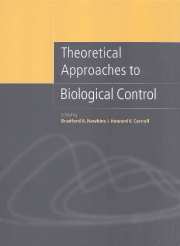Part II - Ecological considerations
Published online by Cambridge University Press: 13 August 2009
Summary
In this section we move from the general development and application of theory to more specific treatments of the ecological, behavioral and physiological factors identified by theory as being important for the implementation of biological control programs. The range of topics is varied, reflecting the complexities that arise when workers want to maximize and sustain population-level impacts of natural enemies of pests.
As previously mentioned, a major goal of theoreticians has been to reconcile the instability of simple host–parasitoid models with the permanence that characterizes successful biological control. This has traditionally been accomplished by adding heterogeneity to the models, whether environmental stochasticity, variability in parasitoid behavior, or differential susceptibility of potential hosts to attack. In Chapter 4, Hochberg & Holt discuss differential susceptibility in the context of host refuges from parasitism. The existence of host refuges is well documented in the empirical literature, and theoreticians have considered their role since the initial development of host–parasitoid theory. Hochberg & Holt use a modified Nicholson–Bailey discrete-time model to illustrate the effect of host refuges, coupled with the host's infinite rate of increase, on the ability of parasitoids to depress host populations.
Mills & Gutierrez (Chapter 5) apply one of the ratio-dependent models introduced by Berryman in Chapter 1. To those raised intellectually on traditional prey-dependent models, this approach will appear much more complex than is usual for a general model.
- Type
- Chapter
- Information
- Theoretical Approaches to Biological Control , pp. 69 - 70Publisher: Cambridge University PressPrint publication year: 1999



